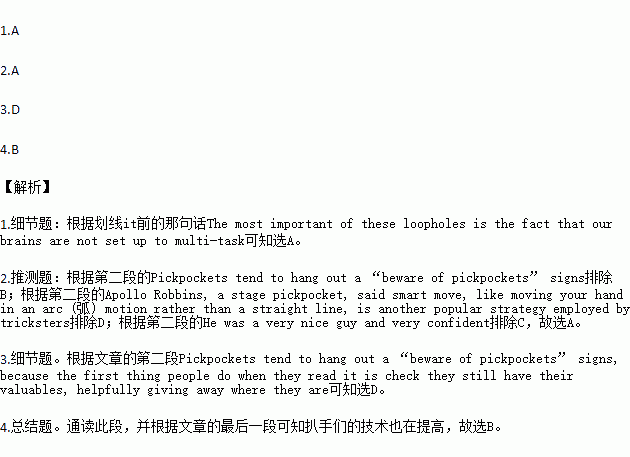题目内容
D
My mom has eyes in the back of her head. She also taught me from an early age to be suspicious of strange men, especially when they give you presents. One day, a “nice man” bearing flowers managed to steal 20 euros from her purse, while she was holding it in her hands. “He said he was collecting for a church charity so I pulled out a euro,” she explains, “He said ‘no, no, that’s too much’ and offered to look in my purse to find a smaller coin. He must have slid out that 20 euro note at the same time. I did not even notice until an hour later. I felt so stupid.”
According to neuroscientists, the key requirement for a successful pickpocket is not having nifty (熟练的) fingers, it’s having a working knowledge of the loopholes (漏洞) in our brain. The most important of these loopholes is the fact that our brains are not set up to multi-task. Most of the time that is a good thing — it allows us to filter (过滤) out all but the most important features of the world around us. But a good trickster can use it to against you. This kind of trick involves capturing all of somebody’s attention with other movements. Street pickpockets often use this effect to their advantage by manufacturing a situation that can not help but overload your attention system. Other strategies are more psychological. Pickpockets tend to hang out a “beware of pickpockets” signs, because the first thing people do when they read it is check they still have their valuables, helpfully giving away where they are. And in my mom’s case, the thief’s best trick was not coming across like a pickpocket. “He was a very nice guy and very confident. Not someone that would cause you to suspect,” she says. Apollo Robbins, a stage pickpocket, said smart move, like moving your hand in an arc (弧) motion rather than a straight line, is another popular strategy employed by tricksters.
At last, it should be pointed out that most thefts are opportunistic. The skill level of most thieves is far less than you think. But they are opportunistic enough to keep up with new technology.
1.What does the underlined word “it” in paragraph 2 refer to?
A. People’s brains are not designed to multi-task.
B. People’s brains can filter out all but the most important features.
C. Somebody’s attention can be distracted by a certain trick.
D. Somebody’s overload attention system.
2.According to the passage, all of the following are pickpocket strategies except _________.
A. having nifty fingers
B. hanging out “beware of pickpockets” sign
C. displaying confidence
D. moving hand in an arc motion
3.In the author’s opinion, _________.
A. people’s brains have many loopholes
B. thieves are more skillful than opportunistic
C. his mom’s losing money is nothing but a by-accident experience
D. signs reminding people of pickpockets can play a negative role in protecting valuables
4.What will the author probably talk about next?
A. Mom’s another suffering
B. Pickpockets concerning new technology
C. Pickpockets’ tricks
D. Apollo Robbins’ stage pickpockets
 名师伴你成长课时同步学练测系列答案
名师伴你成长课时同步学练测系列答案
